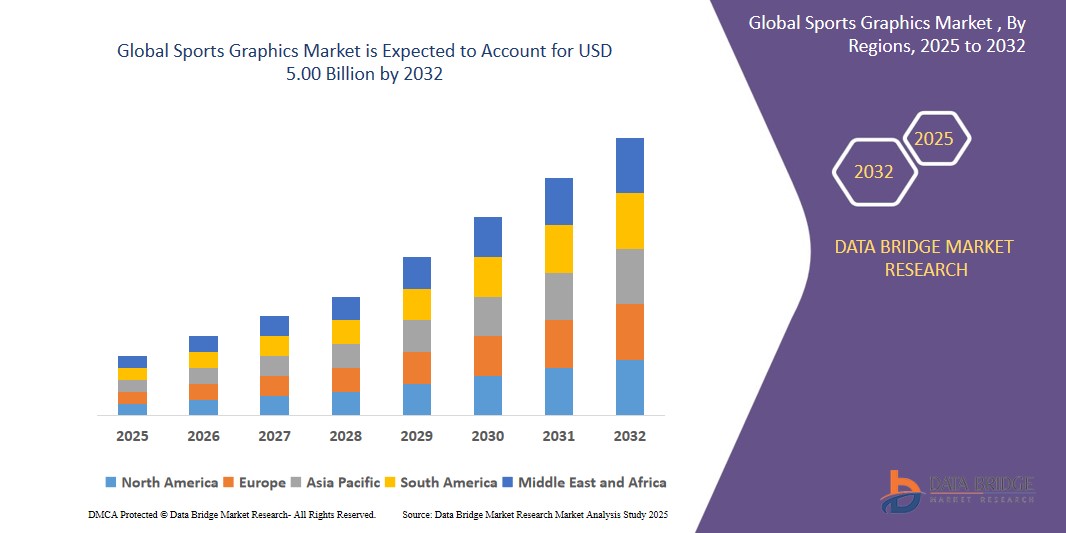The Rising Influence of the Sports Graphics Market: Transforming Fan Experience and Sports Branding
Global Sports Graphics Market Size, Share, and Trends Analysis Report – Industry Overview and Forecast to 2032
- The Global Sports Graphics Market size was valued at USD 2.98 billion in 2024 and is expected to reach USD 5.00 billion by 2032, at a CAGR of 6.70% during the forecast period
https://www.databridgemarketresearch.com/reports/global-sports-graphics-market

In today’s digital-first sports industry, visuals play a vital role in shaping how fans engage with their favorite teams, athletes, and events. The sports graphics market has emerged as a powerful segment, revolutionizing sports broadcasting, marketing, and fan engagement through innovative visual content and design technology. From live broadcasts to social media campaigns and in-stadium displays, graphics have become central to the storytelling and branding ecosystem of modern sports.
Understanding the Sports Graphics Market
The sports graphics market encompasses a wide range of products and services that use visual design, animation, and data visualization to enhance sports communication. This includes motion graphics for live TV coverage, scoreboards, data overlays, augmented reality (AR) visuals, and digital content for web and social platforms. The market’s rapid growth is driven by increasing demand for real-time data visualization, immersive fan experiences, and the global expansion of sports media platforms.
Sports organizations, broadcasters, and marketing agencies are now investing heavily in graphic technologies to capture attention and strengthen brand loyalty. Whether it’s showcasing player statistics, visualizing game strategies, or creating promotional content, sports graphics have become an essential communication tool.
Market Growth Drivers
1. Expansion of Sports Broadcasting and Streaming
The rise of high-definition and 4K broadcasting, coupled with the boom in online sports streaming, has significantly boosted demand for high-quality graphics. Broadcasters use real-time graphics and animations to present complex data in a visually appealing and easily digestible format. Live scoreboards, instant replays, and virtual analysis tools enhance the viewing experience, making sports broadcasts more interactive and informative.
2. Increasing Popularity of Esports and Virtual Sports
Esports has become a global phenomenon, bringing with it a new set of design and visualization needs. Graphics are essential in esports for displaying live stats, player rankings, and game progress. The fusion of gaming aesthetics with traditional sports presentation styles has created new opportunities for graphic designers and software developers.
3. Technological Advancements
The integration of artificial intelligence (AI), augmented reality (AR), and virtual reality (VR) has redefined sports graphics. AI-powered systems can automatically generate player performance visuals, predict outcomes, or highlight moments in real time. AR and VR applications are being used to create immersive visualizations during live events or digital broadcasts, giving audiences a closer connection to the action.
4. Growing Role of Social Media and Digital Marketing
Social media platforms have become vital tools for sports promotion. Teams and brands rely on eye-catching graphics for match previews, player highlights, and fan engagement posts. Real-time updates, infographics, and motion designs increase online visibility and engagement rates. With the growing dominance of short-form video platforms, such as Instagram Reels and TikTok, the demand for dynamic, shareable graphics continues to soar.
Applications of Sports Graphics
1. Live Broadcasting
Sports graphics are indispensable in broadcasting, offering real-time updates such as scores, statistics, and player information. Advanced tools like virtual scoreboards, lower thirds, and animated replays enhance visual appeal. In addition, broadcasters use data visualization to provide analytical insights, such as heat maps and performance comparisons.
2. In-Stadium Displays
Large LED screens and jumbotrons have become key features of modern stadiums. These displays use sports graphics for live scores, advertisements, and fan messages. Real-time visuals keep audiences engaged and contribute to the overall atmosphere of the event.
3. Sports Marketing and Branding
Teams and sponsors use visually appealing graphics to strengthen their branding. From logo animations to uniform design previews and event posters, every visual element contributes to brand identity. Creative use of graphics helps teams maintain a consistent look across all marketing channels.
4. Data Visualization and Analytics
As sports become increasingly data-driven, the visualization of performance metrics is vital. Coaches, analysts, and fans all benefit from data presented through interactive graphics. Tools like dashboards and digital reports help convert complex numbers into clear insights.
5. Fan Engagement Platforms
Sports graphics are also integrated into mobile apps, websites, and AR-based experiences. Fans can access live stats, personalized content, or virtual experiences that enhance their connection with their favorite teams. Interactive visual content keeps audiences engaged even beyond the duration of live matches.
Regional Insights
The sports graphics market exhibits strong growth across key regions:
North America leads the global market, driven by advanced sports media networks, high investment in sports technology, and a strong presence of professional leagues like the NFL, NBA, and MLB.
Europe follows closely, with major sports such as football and tennis driving visual innovation in broadcasting and fan engagement.
Asia-Pacific is emerging rapidly due to the expansion of sports leagues, esports popularity, and growing digital infrastructure. Countries like India, Japan, and South Korea are witnessing increased investment in sports media production.
Middle East and Africa are gradually adopting sports graphics technologies as sports tourism and events like the FIFA World Cup create demand for high-quality media coverage.
Challenges in the Sports Graphics Market
While opportunities are abundant, the market also faces several challenges.
High production costs: Creating high-end graphics for broadcasts or virtual platforms requires sophisticated software and skilled professionals.
Integration complexity: Combining live data feeds with real-time visuals demands robust infrastructure and coordination.
Copyright and data usage issues: Using official player statistics or imagery involves strict licensing, which can restrict creative freedom.
Technology adaptation: Traditional broadcasters and smaller sports organizations often struggle to adopt modern technologies like AR or AI due to limited budgets.
Despite these challenges, technological advancements and growing awareness of digital transformation are helping overcome barriers.
Future Trends and Opportunities
The future of the sports graphics market looks promising, shaped by several evolving trends:
AI-Generated Graphics: Artificial intelligence will increasingly automate the creation of real-time visuals, helping broadcasters generate instant highlight reels or data-driven infographics.
Immersive Fan Experiences: AR and VR-based graphics will bring fans closer to live action, offering virtual seats or interactive overlays during games.
Personalization: Data analytics will enable customized visuals for individual viewers based on their favorite teams or players.
Sustainability and Cost Efficiency: Cloud-based production tools will reduce equipment costs and make graphics more accessible to smaller organizations.
Cross-Platform Integration: Sports graphics will seamlessly adapt across TV, web, and mobile platforms, ensuring consistent visual storytelling across all digital touchpoints.
Conclusion
The sports graphics market is no longer just a creative support function — it is a driving force behind the evolution of sports entertainment and communication. As technology continues to advance, sports graphics will play a central role in creating immersive experiences, enhancing data presentation, and strengthening the emotional connection between teams and their fans.
Browse More Reports :
Global Critical Communication Market
Global Educational Robot Market
Global Kitchen Sinks Market
Global People Counting System Market
Global Premium Spirits Market
Global Pretzels Market
Global Shoe Insole Market
Global Smartwatch Market
Global Sports Graphics Market
Global Sports Technology Market
Global Surface Water Sports Equipment Market
Asia-Pacific Health And Wellness Food Market
Egypt Medical Devices Market
North America Recovered Carbon Black (rCB) Market
South Africa Safety Shoes Market
- Art
- Causes
- Crafts
- Dance
- Drinks
- Film
- Fitness
- Food
- Jeux
- Gardening
- Health
- Domicile
- Literature
- Music
- Networking
- Autre
- Party
- Religion
- Shopping
- Sports
- Theater
- Wellness


